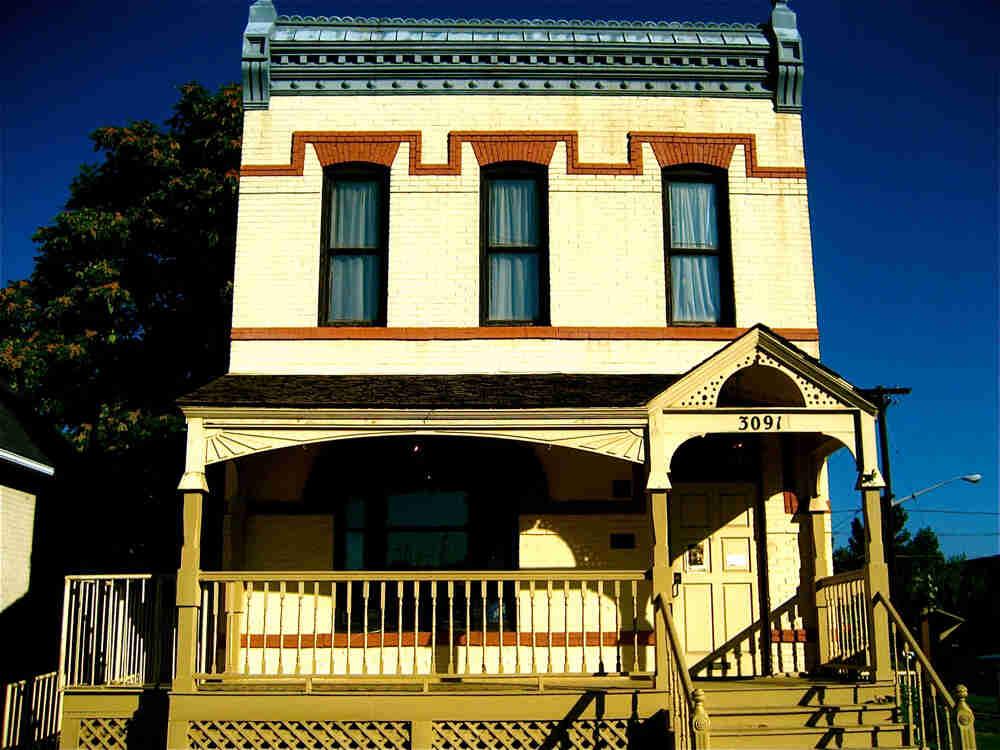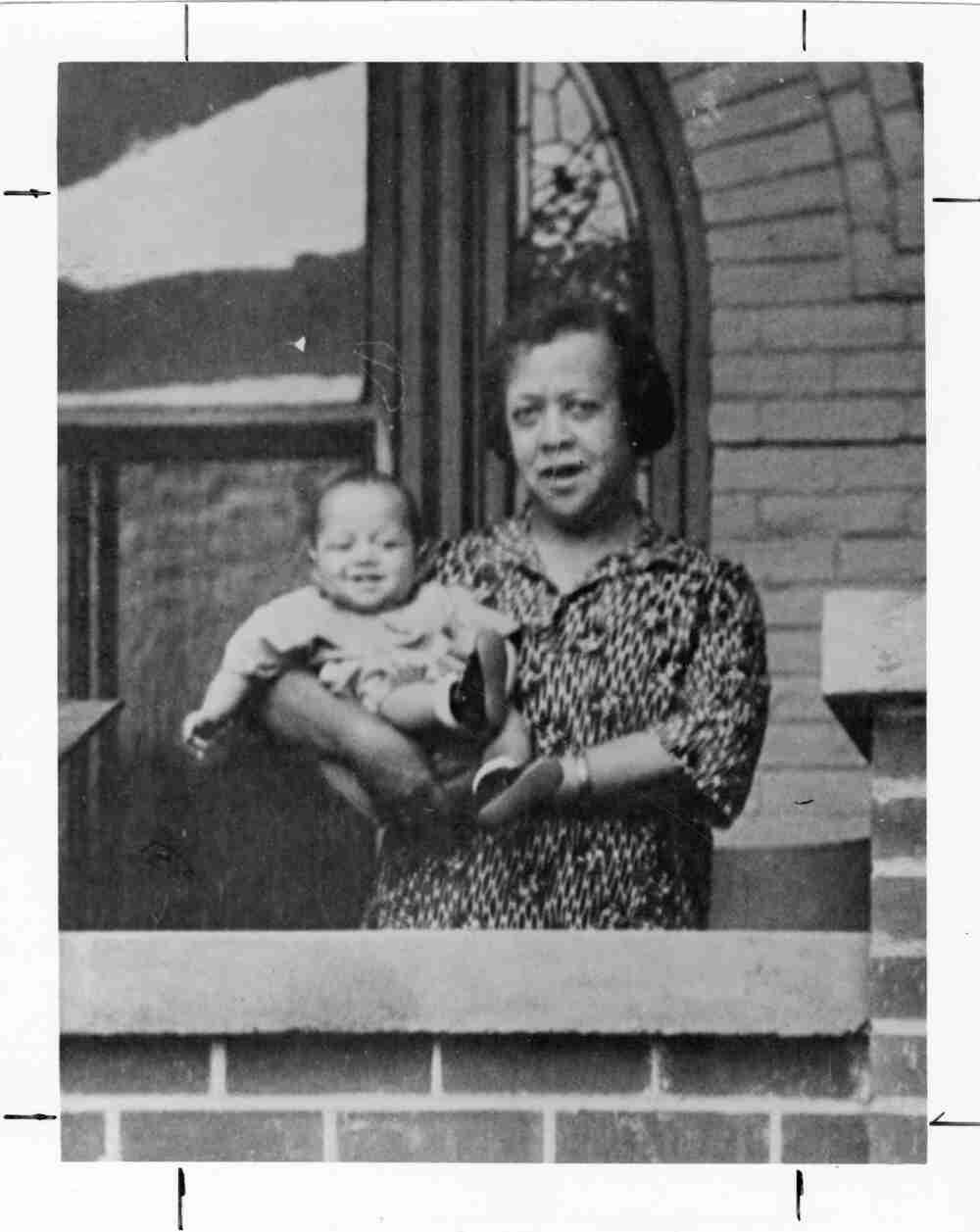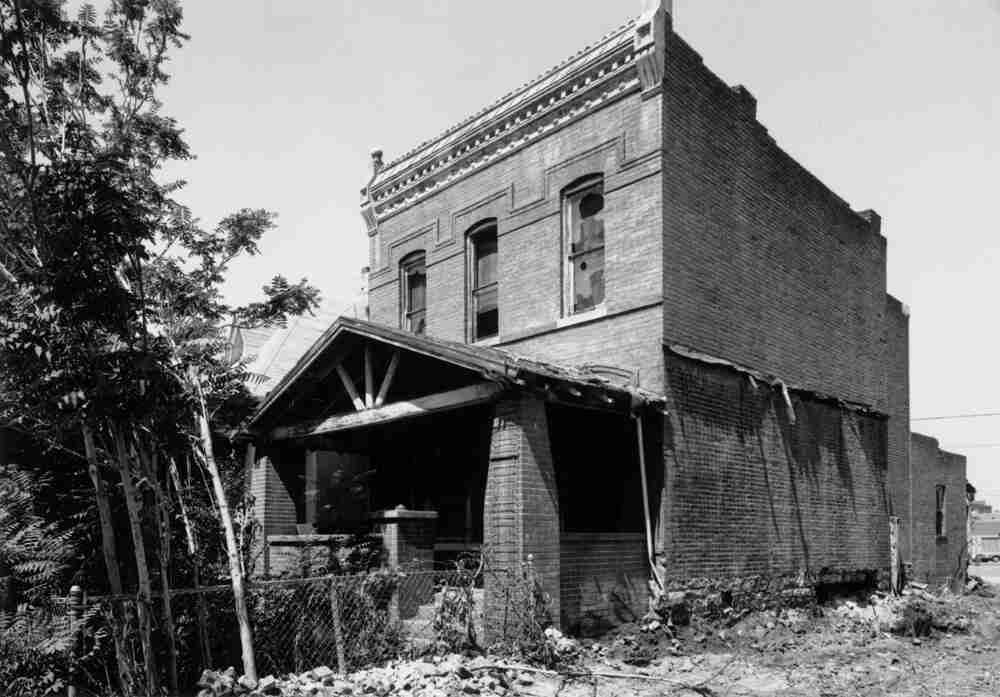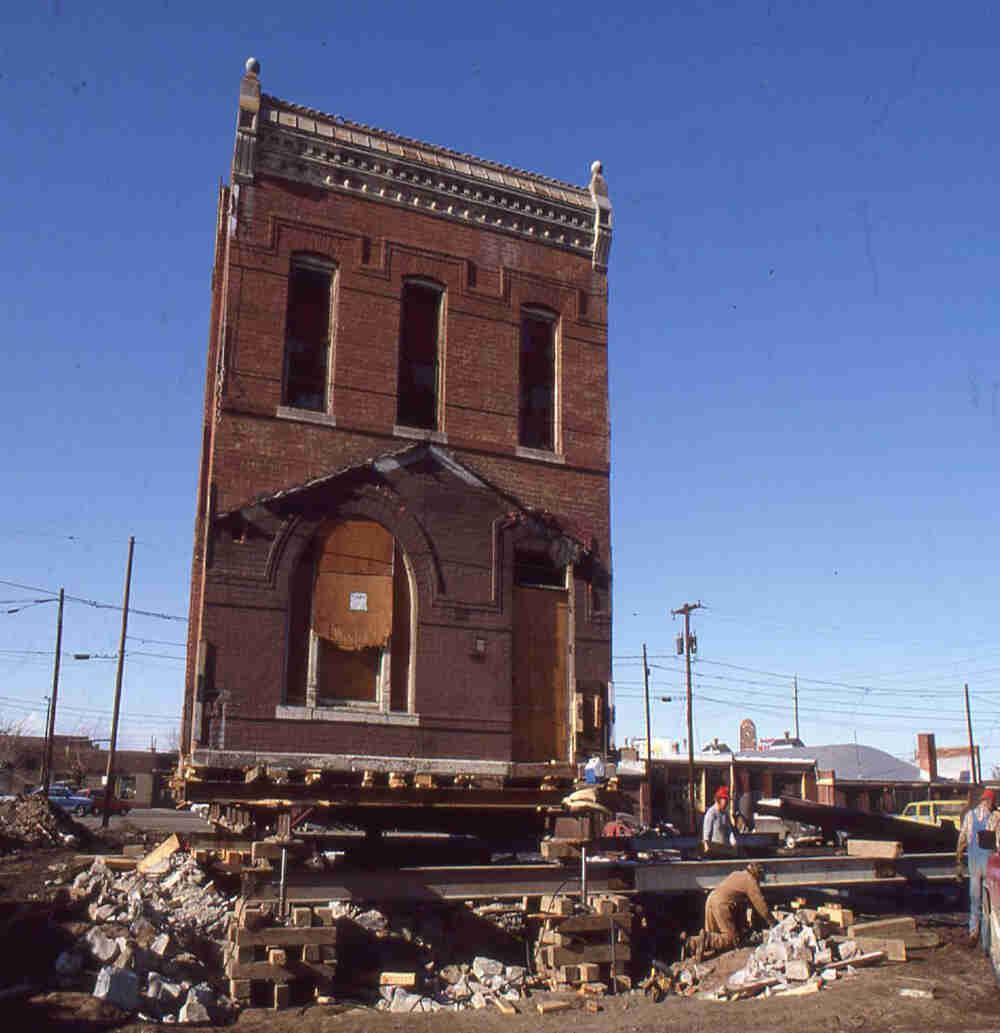Justina Ford House
Full Article
Built in 1890 at 2335 Arapahoe Street in Denver, the Justina Ford House served for forty years as the home and office of Colorado’s first black woman physician. In 1984 the house was moved to save it from demolition, and after renovations it opened at 3091 California Street as the new home of the Black American West Museum. In 1998 a statue of Ford was erected across the street at the Regional Transportation District’s Thirtieth and Downing light rail station.
Justina Ford’s House
What is now known as the Justina Ford House was originally built in 1890 on Arapahoe Street in the Curtis Park neighborhood of Denver. The house was a simple two-story rectangular box of red brick with an Italianate façade on a stone foundation. When the house was built, Germans, Irish, Jews, and other European immigrant groups were settling the neighborhood, and the Ford House’s first owner was a Jewish Denverite named Isaac Kohn. Kohn’s son, Samuel E. Kohn, also lived in the house; in 1898 he cofounded the American Furniture Company, now known as American Furniture Warehouse, which he ran until his death in 1943.
Isaac Kohn sold the house by 1902, the year Ford came to Denver. Born in Illinois in 1871, she graduated from Hering Medical College in Chicago in 1899 and practiced briefly in Alabama before moving to Colorado. She received her Colorado medical license in October 1902, becoming the state’s first black woman doctor.
Ford settled in Curtis Park, which in the early twentieth century was shifting to a more heavily black population. After moving several times during her early years in Denver, by 1912 she had established a successful practice and bought the former Kohn house on Arapahoe Street from Morris and Fanny Abromovitz. For the next forty years, she lived in the house and saw patients in a room on the first floor. By the time of her death in 1952, she had become a well-respected member of the Denver medical community, estimated to have delivered more than 7,000 babies in her fifty years in Colorado.
Rebirth as Black American West Museum
After Ford’s death, the area around her house declined as the end of racially restrictive housing covenants made it possible for middle-class blacks to move out of Curtis Park and Five Points. In 1982 a private developer acquired the block where her house was located and planned to clear the whole area to make way for a parking lot and other development. Local residents, led by Moses Valdez, lobbied to delay demolition to allow them time to figure out how to save the Ford House. The developer agreed to donate the house to a nonprofit if the nonprofit would cover the costs of moving it to a different location. Meanwhile, the Ford House was the only building left standing on its block.
Meetings between the developer, the community, Historic Denver, and the Black American West Museum led to a plan in which Historic Denver would pay for the Ford House to be moved to the east side of the Curtis Park neighborhood, where it would be renovated and used as the museum’s new home. In February 1984, beams were placed under the house so that it could be jacked up, placed on a wheeled platform, and towed about a mile to 3091 California Street. There, the house was renovated, and its original wood porch was reconstructed using historical photographs.
In 1989 the Black American West Museum, which had had no permanent home since Paul Stewart founded it in 1971, opened in the relocated and renovated Ford House with roughly 1,500 artifacts on display. The house still serves as the museum’s home and is easily accessible via the Regional Transportation District’s Thirtieth and Downing station, which opened across the street in 1994 and added a statue commemorating Ford in 1998.
10th Grade
Justina Ford was Colorado’s first African American woman physician. The Justina Ford House served for forty years as her home and office. The house was built in 1890 at 2335 Arapahoe Street in Denver. In 1984 the house was moved to save it from demolition. After renovations, it opened at 3091 California Street as the new home of the Black American West Museum. In 1998 a statue of Justina Ford was erected to honor her contributions to the community.
Justina Ford’s House
The Justina Ford House was built in 1890 on Arapahoe Street in the Curtis Park neighborhood of Denver. The house was a modest two-story rectangular box of red brick with an Italianate façade on a stone foundation. When the house was built, Germans, Irish, Jews, and other European immigrant groups lived the neighborhood.
The Ford House’s first owner was a Jewish Denverite named Isaac Kohn. Samuel E. Kohn, his son, also lived in the house. In 1898, Samuel founded the American Furniture Company, now known as American Furniture Warehouse. Isaac Kohn sold the house around 1902.
Justina Ford was born in Illinois in 1871. She graduated from Hering Medical College in Chicago in 1899 and practiced in Alabama before moving to Denver in 1902. She received her Colorado medical license in October 1902. She became the state’s first African American woman doctor.
Ford settled in Curtis Park, which was changing to an African American neighborhood. The Curtis Park area is also called Five Points. At that time, African Americans were not allowed to live in some neighborhoods because of their race. Many Denver neighborhoods had “restrictive covenants” or rules that said that minorities could not buy property in certain places. Curtis Park and Five Points did not have restrictive covenants. As a result, the neighborhood became a thriving African American community.
Justina Ford lived in several places in the Five Points area during her early years in Denver. By 1912, she had established a successful medical practice. She bought the former Kohn house to use as a home and office. For the next forty years, she lived in the house and saw patients in a room on the first floor. By the time of her death in 1952, she had become a well-respected member of the Denver medical community. Dr. Ford’s specialty was delivering babies. It is estimated that she delivered more than 7,000 babies in her fifty years working in Colorado.
Rebirth as Black American West Museum
After Ford’s death, the area around her house declined. Restrictive housing based on race ended and middle-class African Americans moved out of Curtis Park and Five Points. The neighborhood became run down and poverty-stricken. Since the area was close to downtown Denver, people considered using the land for other purposes. In 1982 a private developer acquired the block where Dr. Ford’s house was located. He planned to tear down all houses in the area to make way for a parking lot and businesses.
Moses Valdez and other local residents wanted to preserve the house to honor Dr. Justina Ford and her contributions to the community. They lobbied to delay demolition to allow them time to save the Ford House. The developer agreed to donate the house if they could move it to a different location. Meanwhile, the Ford House was the only building left standing on its block.
After negotiations, a plan was developed. Historic Denver, an organization that strives to preserve historic buildings, paid for the Ford House to be moved to the east side of the Curtis Park neighborhood. The Black American West Museum was looking for a building to house its collection, so the house would be renovated and used as the museum’s new home.
In February 1984, beams were placed under the house. It was jacked up, placed on a wheeled platform, and towed about a mile to 3091 California Street. There, the house was renovated. Its original wood porch was reconstructed using historical photographs.
The Black American West Museum opened in the relocated Ford house in 1989. It had not had a permanent home since Paul Stewart founded it in 1971. The 1,500 artifacts in its collection were put on display. The Ford house still serves as the museum’s home. A statue commemorating Dr. Justina Ford was placed outside the house in 1998. The museum is across from the RTD’s Thirtieth and Downing station.
8th Grade
Justina Ford was Colorado’s first African American woman physician. The Justina Ford House served for forty years as her home and office. The house was built in 1890 at 2335 Arapahoe Street in Denver. To save it from demolition, the house was moved in 1984. It opened as the new home of the Black American West Museum. In 1998 a statue of Justina Ford was erected across the street at the RTD light rail station at Thirtieth and Downing.
Justina Ford’s House
The Justina Ford House was built in 1890 on Arapahoe Street in the Curtis Park neighborhood of Denver. The house was a simple two-story rectangular box of red brick. It had an Italianate façade on a stone foundation. When the house was built, Germans, Irish, Jews, and other European immigrant groups lived the neighborhood.
The Ford House’s first owner was a Jewish Denverite named Isaac Kohn. Samuel E. Kohn, his son, also lived in the house. In 1898, Samuel founded the American Furniture Company, now known as American Furniture Warehouse. Isaac Kohn sold the house around 1902.
Dr. Justina Ford moved to Denver in 1902. She was born in Illinois in 1871. She graduated from Hering Medical College in Chicago in 1899. Before moving to Colorado she was a doctor in Alabama. Her Colorado medical license was issued in October 1902. She became the state’s first African American woman doctor.
Ford settled in Curtis Park, which was changing to an African American neighborhood. At that time, African Americans were not allowed to live in some neighborhoods because of their race. Many Denver neighborhoods had “restrictive covenants” or rules that said that minorities could not buy property. Curtis Park did not have these rules. As a result, it became a thriving African American community. The Curtis Park area is also called Five Points.
Justina Ford moved several times during her early years in Denver. By 1912 she had established a successful practice. She bought the former Kohn house to use as a home and office. For the next forty years, she lived in the house and saw patients in a room on the first floor. By the time of her death in 1952, she had become a well-respected member of the Denver medical community. It is estimated that she delivered more than 7,000 babies in her fifty years in Colorado.
Rebirth as Black American West Museum
After Ford’s death, the area around her house declined. Restrictive housing based on race ended. Middle-class African Americans moved out of Curtis Park and Five Points. The neighborhood became run down. Since the area was close to downtown, people were looking to use the land for other purposes. In 1982 a private developer acquired the block where her house was located. He planned to tear down all houses in the area to make way for a parking lot and businesses.
Moses Valdez and other local residents wanted to preserve the house to honor Dr. Justina Ford and her contributions to the community. They lobbied to delay demolition to allow them time to save the Ford House. The developer agreed to donate the house if they could move it to a different location. Meanwhile, the Ford House was the only building left standing on its block.
Meetings between the developer, the community, Historic Denver and the Black American West Museum led to a plan. Historic Denver is an organization that strives to preserve historic buildings. Historic Denver paid for the Ford House to be moved to the east side of the Curtis Park neighborhood. The Black American West Museum was looking for a building to house its collection. The house would be renovated and used as the museum’s new home.
In February 1984, beams were placed under the house. It was jacked up, placed on a wheeled platform and towed about a mile to 3091 California Street. There, the house was renovated. Its original wood porch was reconstructed using historical photographs.
The Black American West Museum opened in the relocated Ford house in 1989. It had not had a permanent home since Paul Stewart founded it in 1971. The 1,500 artifacts in its collection were put on display. The Ford house still serves as the museum’s home. A statue commemorating Dr. Justina Ford was placed outside the house in 1998. The museum and is across from the RTD’s Thirtieth and Downing station.
4th Grade
Dr. Justina Ford was Colorado’s first African American woman doctor. The Justina Ford House was her home and doctor’s office. The house was almost torn down, but people wanted to save the house to honor Justina Ford. They found a way to save the house. It was moved to another location. It is now the Black American West Museum. A statue of Justina Ford is outside the museum.
Justina Ford’s House
The Justina Ford House was built in 1890. Its address was 2335 Arapahoe Street. It was in the Curtis Park neighborhood of Denver. The house was a plain red brick, two-story home. When the house was built, European immigrants lived in the neighborhood.
The house’s first owner was a Jewish man named Isaac Kohn. His son, Samuel Kohn, also lived in the house. In 1898, Samuel started the American Furniture Company. That company still exists. It is called American Furniture Warehouse. Isaac Kohn sold the house around 1902.
Justina Ford was born in Illinois in 1871. She graduated from medical school in 1899. She worked as a doctor in Alabama. Then, she moved to Denver in 1902. She earned her Colorado medical license. She became Colorado’s first African American woman doctor.
Ford moved into the Curtis Park neighborhood. African American people were moving to the neighborhood. At that time, African Americans were not allowed to live in some neighborhoods because of their race. Many neighborhoods had rules that said that minorities could not live there. Curtis Park did not have these rules. As a result, it became a thriving African American community.
Justina Ford established a successful practice by 1912. She bought the house to use as a home and office. For the next forty years, she lived in the house. She saw patients in a room on the first floor. She was an important part of the community. Her specialty was delivering babies. She delivered more than 7,000 babies in her fifty years in Colorado. Dr. Ford died in 1952.
Rebirth as Black American West Museum
The Curtis Park Neighborhood was changing. The rules that said African Americans could not live in certain places ended. So, African Americans were moving to other parts of Denver. The neighborhood became run down. Curtis Park was close to downtown. Developers wanted the land for other purposes. In 1982 a developer bought the block where her house was located. He planned to tear down all the homes. He wanted to build a parking lot and offices.
People who lived in Curtis Park wanted to save Dr. Justina Ford’s house. They wanted to remember Justina Ford and her contributions to the community. They talked to the developer. He said he would not tear down the house. He would give it to them and they could move it. The Ford House was the only building left standing on the block.
They came up with a plan. Historic Denver was an organization that valued Denver history. They paid for the house to be moved to another site in Curtis Park. The Black American West Museum needed a building. Justina Ford’s house would be fixed up and used as the museum’s new home.
In February 1984, beams were placed under the house. It was jacked up and placed on a wheeled platform. It was towed a mile to its new location at 3091 California Street. The house was fixed up. Its wood porch was rebuilt using historic photos.
The Black American West Museum opened in the Justina Ford’s house in 1989. Paul Stewart, the museum’s founder, put 1,500 objects on display. The house still serves as the museum’s home. The museum is across the street from RTD’s Thirtieth and Downing Light Rail station. A statue of Justina Ford stands in the area to remind people of her importance in Denver’s history.












